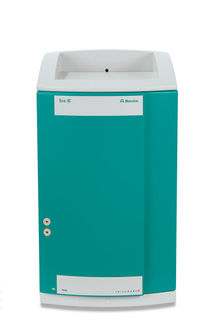To use all functions of this page, please activate cookies in your browser.
my.chemeurope.com
With an accout for my.chemeurope.com you can always see everything at a glance – and you can configure your own website and individual newsletter.
- My watch list
- My saved searches
- My saved topics
- My newsletter
Haplogroup R1a (Y-DNA)R1a (Y-DNA) is a specific sequence of nucleotides in the male Y chromosome and a Y-chromosome haplogroup identified with the genetic marker M17. R1a originated as a single mutation of one male, the R1a originator considered to be the ancestor of all individuals carrying R1a, and descends of Haplogroup R1. R1a is present at high frequency (40 per cent plus) from the Czech Republic across to the Altai Mountains in Siberia and south throughout Central Asia. The first carriers of the R1a haplotype are believed to have been peoples living about 15,000 years ago[1] confined by an area within the Ukrainian LGM refuge. The gene spread by a nomadic lifestyle and proliferated on Eurasian steppes. Product highlight
SubcladesThere is some suggestion that R1a and R1a1 split within Southern and Western Asia. Several possibilities for the spread of R1a and R1a1 exist, which include recent Slavic migration from the 5th century AD, movement of Kurgan people (that is, the spread of the Indo-European languages) associated with the domestication of the horse and/or the re-colonization of Europe following the end of the last ice-age. OriginsAbsolute dating methods suggest that this marker is 10–15,000 years old, and the microsatellite diversity is greatest in southern Russia and Ukraine, suggesting that it arose there. Investigations suggest the gene expanded from the Dniepr-Don Valley, between 13 000 and 7600 years ago, and was linked to the reindeer hunters of the Ahrensburg culture that started from the Dniepr valley in Ukraine and reached Scandinavia 12 000 years ago.[2] Ornella Semino et al. (see [3]) propose a postglacial spread of the R1a1 gene from the Ukrainian LGM refuge, subsequently magnified by the expansion of the Kurgan culture into Europe and eastward. R1a1 is most prevalent in Poland, Russia, Ukraine, Hungary and is also observed in Pakistan, India and central Asia. Wells suggests the origin, distribution and age of R1a1 points to an ancient migration, possibly corresponding to the spread by the Kurgan people in their expansion across the Eurasian steppe around 3000 BC.[3] Current theories point to the gene being tied to speakers of the Proto-Indo-European language in the Kurgan scenario, spreading the gene further to Asia and most of Europe. The low occurrence of R1a1 in Western European Indo-European speaking populations, most notably the region west of the Vistula[4] — including the enigmatic Nordwestblock — shows that this correlation with PIE cannot be extended to the "kurganized" western Corded ware and subsequent Beaker culture.[5][6] This corresponds to the now widely accepted view that kurganisation never occurred.[7] Highest haplotype incidence suggests that haplogroup R1a1 originated among the ancestors of the Balto-Slavic speakers of Eastern and Central Europe. Marijana Perii &all in 2005 hypothesize that: At this level of resolution, it is not clear what temporal and effective population size differences contributed to this deep Paleolithic signal as high R1a variance in SEE might be explained by either ancient demography or more recent bottlenecks and founder effects in different Slavic tribes. At least three major episodes of gene flow might have enhanced R1a variance in the region: early post-LGM recolonizations expanding from the refugium in Ukraine, migrations from northern Pontic steppe between 3000 and 1000 B.C., as well as possibly massive Slavic migration from A.D. 5th to 7th centuries. Distribution OverviewIn Europe, the highest frequencies are found in Central and Eastern Europe. Today it is found at its highest levels in Tajiks (64%), Kyrgyz (63%), Poland and Hungary (56%–60%), Ukraine (44-54%[8], depending on the source), and Russia, where one out of two men has this haplogroup. In Hungary contradicting frequencies are reported 60% or 20%. Relatively high frequencies are also found among the ethnic Sorbs (63%) in Eastern Germany and in Scandinavia[2] (the largest being 23% in Iceland). The modern population of Ukraine has the highest level of diversity of the gene making it the likeliest location of its origin.[2] High haplotype diversity was detected in northern Poland where for 508 males Pawlowski et al[9] found 328 different and 264 unique haplotypes, he wrote "Model for a Polish population haplotype …is almost 15 times more frequent in our population than in a cumulative European one" (for better picture compare this diversity to this map of R1a1 frequency) or more accurate map C on this map[10]. Even in South Eastern Europe (not a major concentration of R1a1) microsatellite networks of major Y chromosomal lineages show high diveristy of R1a1 graph C[10][11]. The variance cluster in South Eastern Europe (SEE) is located in the Republic of Macedonia. EuropeR1a1 is spread across the whole of Europe, with the highest concentrations found in Poland. The two main directional components of the spread are consistent with an East to West migration as well as a radial spread from the Balkans. The latter is claimed to be a trace of the re-population of Europe after the Last Glacial Maximum from the Ukrainian refuge area.[12] "At least three major episodes of gene flow might have enhanced R1a variance in the region: early post-LGM recolonizations expanding from the refugium in Ukraine, migrations from northern Pontic steppe between 3000 and 1000 B.C., as well as possibly massive Slavic migration from A.D. 5th to 7th centuries." ref The last possibility is less probable, the distribution of Paleolithic pattern depth is unexplained by massive people flow. Genetic data support autochtonic school of Slovian historiography. India
In India initial studies with limited samples observed a correlation between the Brahmin caste and the R1a haplogroup which was consistent with an Indo-Aryan migration from Central Asia (Bamshad et al. 2001),[13] in line with earlier suggestions (Cavalli-Sforza 1994).[14] The frequency gradients of the haplogroup, falling off eastward across Siberia to the Altai mountains and southward into India, were held to perfectly reflect the inferred migrations of the (pre-)Proto-Indo-Iranians and Indo-Iranians during the period 3000 to 1000 BC (Wells et al 2001).[1] The northern migration theory is also supported by the dating of the haplogroup (Wells et al 2003). However, Studies of India scholars showed the R1a lineage forms around 35–45% among all the castes in North Indian population (Namita Mukherjee et al. 2001) and the Badagas of the Nilgiris making the association with the Brahmin caste more vague. A further study (Saha et al 2005)[15] examined R1a1 in South Indian tribals and Dravidian population groups more closely, and questioned the concept of its Indo-Iranian origin. Most recently Sengupta et al. (2006)[16] have confirmed R1a's diverse presence including even Indian tribal and lower castes (the so-called untouchables) and populations not part of the caste system. From the diversity and distinctiveness of microsatellite Y-STR variation they conclude that there must have been an independent R1a1 population in India dating back to a much earlier expansion than the Indo-Aryan migration. The pattern of clustering does not support the model that the primary source of the R1a1-M17 chromosomes in India was Central Asia or the Indus Valley via Indo-European speakers.[17] According to Sengupta et al. (table 5),[16] R1* is virtually absent in Southeast and East Asia. AsiaIn Asia, high R1a1 frequencies are detected in populations of Ishkashimi (68%), Tajiks (64%), and Kyrgyz (63%).[1][18] "The exceptionally high frequencies of this marker in the Kyrgyz, TajikyKhojant, and Ishkashim populations are likely to be due to drift, as these populations are less diverse, and are characterized by relatively small numbers of individuals living in isolated mountain valleys". If the size of a population decreases, for example, in a particular fraternal family all male members will have 100% of R1a1 or 0% of this marker. The gene has proven to be a diagnostic Indo-Iranian marker[1] and is believed to have been inherited from people who left a clear pattern of archaeological remains known as the Kurgan culture, generally identified as early Indo-Europeans, and later by the Vikings,[2] which accounts for the existence of it in, among other places, the British Isles.[19][20] Lower frequencies of R1a1 are found among populations of West Asia. Iran appears to have had little genetic influence from the R1a1-carrying Indo-Iranians,[1] attributed to language replacement through the "elite-dominance" model. Frequency distributionR1a frequency is expressed as percentage of population samples. Europe N *R1 R1a1 source
Sorbs 112 - 63.39 2
Hungarian 45 13.3 60.0 1 ?-14
Poles 55 16.4 56.4 1,14
Ukrainian 50 2.0 54.0 1,14
Belarusian 306 50.98 2 ?-14
Russian 122 7.0 47.0 14
Belarusian - 46 4
Belarusian 41 10.0 39.0 14
Ukrainian - 44 3 ?
Ukrainians, Rashkovo 53 41.5 10 ?
Russian, North 49 0 43 5
Latvian 34 15.0 41.0 14
Udmurt 43 11.6 37.2 1
Pomor 28 0 36 5
Macedonian, R.Macedonia 79 15.2 15
Macedonian, North.Greece 20 10.0 35.0 1
Moldavians, Karahasan 72 34.7 10
Croatian 34 15e
Lithuanian 38 6 34 14
Croatian 58 10.3 29.3 1
UK Orkney 26 65 27 5
Gagauzes, Etulia 41 26.8 10
Czech + Slovakian 45 35.6 26.7 1,14
Norwegian 83 26.5 13
Bosnians 25 15e
Icelander 181 41.4 23.8 14
Norwegian 87 21.69 2
Moldavians, Sofia 54 20.4 10
Romanians 54 20.4 10 (Buhusi, Piatra-Neamt)
Hungarian 45 13.3 20.4 14
Orcandin 71 66.0 19.7 14
Swedish (Northern) 48 23.0 19.0 14
Swedish 110 20.0 17.3 14
Danish 12 41.7 16.7 14
Herzegovinian 15 15e
Mari 46 0 13.0 1
German 88 12.50 2
German 48 47.9 8.1 14
Greek 76 27.6 11.8 1
Albanian 51 17.6 9.8 1
Albanian 10 15e
Saami 24 8.3 8.3 1
UK Isle of Man 62 15 8 11
Greek 8 15e
UK Orkney 121 23 7 11 ?? 7% <> 23% *5
UK 309 ~7 13 see references
Georgian 63 ` 14.3 7.9 1
Turks 7 15e
Turkish 30 6.6 6.6 1
UK Shetland 63 17 6 11
UK Chippenham 51 16 6 11
UK Cornwall 52 25 6 11
Dutch 27 70.4 3.7 1
German 16 50.0 6.2 1
Italian central/north 50 62.0 4.0 1
Italians 3 15e
British ~1000 ~4 11
Irish 222 81.5 0.5 14
Calabrian 37 32.4 0 1
Sardinian 77 22.1 1
British 25 72 0 5
Poles 913 9
Germans 1215 9
Dniester-Carpathian - 50.06 10
Gagauzes, Kongaz 48 12.5 10
empty or - = no data in sample. ? = datasets differences, [?-x]:= ^x=# source
empty or - = no data in sample. ? = datasets differences, [?-x]:= ^x=# source
Asia N R1* R1a1(%) Sr. Published
Ishkashimi 25 4 68 5 Spencer Wells,2001
Tajiks - 64 6
Tajiks/Khojant 22 64 5 Spencer Wells,2001
Tajiks/Dushanbe 16 19 5 Spencer Wells,2001
Tajiks/Samarkand 40 25 5 Spencer Wells,2001
Kyrgyz 52 2 63 5 Spencer Wells,2001
Tashkent IE 69 7 47 ?
India Upper Caste 86 - 45.35 8
Sourasthran 46 0 39 5 Spencer Wells,2001
Abkhazians 12 8 33 7 Nasidze,2004
Chenchus (India-Drav.) - - 26 12
Kazan Tatar 38 3 24 5 Spencer Wells,2001
Saami 23 9 22 5 Spencer Wells,2001
Dongxiang 49 <10 28 Wei Wang et al.,2003
Bonan 47 0 26 Wei Wang et al.,2003
Salar 52 <10 17 Wei Wang et al.,2003
Iran (Tehran) 24 4 4 5 Spencer Wells,2001
Iran (Tehran) 80 8 20 7 Nasidze,2004
Iran (Isfahan) 50 0 18 7 Nasidze,2004
Pakistan ?? 85 1.10 16.47 8 ?
Pakistan 175 0.57 24.43 8 ?
Pakistan south 91 0 31.87 8 ?
India 728 0 15.8 8 ?
India 325 0.3 27 12 ?
Tuvian 42 2 14 5 Spencer Wells,2001(*5)
Abazinians 14 0 14 7 Nasidze,2004(*7)
Turks 39 31 13 7 Nasidze,2004(*7)
Georgians 77 10 10 7 Nasidze,2004(*7)
Kurd 17 29 12 5 Spencer Wells,2001(*5)
Nenets 54 4 11 5 Spencer Wells,2001(*5)
Syrian 20 15 10 1
Lebanese 31 6.4 9.7 1
Turkmen 37 36 9 ?
Turkmen 30 37 7 5 Spencer Wells,2001(*5)
Lezgi(S.Caucasus) 12 17 8 7 Nasidze,2004(*7)
Svans 25 0 8 7 Nasidze,2004(*7)
Azerbaijanians 72 11 7 7 Nasidze,2004(*7)
Armenians 100 19 6 7 Nasidze,2004(*7)
Armenians 47 36 9 5 Spencer Wells,2001(*5)
S.Ossetians 17 12 6 5 Spencer Wells,2001(*5)
Kazaks 54 6 4 5 Spencer Wells,2001(*5)
Chechenians 19 0 5 7 Nasidze,2004(*7)
Kallar Dravidian 84 0 4 5 Spencer Wells,2001(*5)
Mongolian 24 0 4 5 Spencer Wells,2001(*5)
Ossetians (Ardon) 28 0 4 7 Nasidze,2004(*7)
Kazbegi 25 8 4 7 Nasidze,2004(*7)
India Dravidian (Tribal) 180 - 2.78 8
Kabardinians 59 2 2 7 Nasidze,2004(*7)
Lezgi(Dagestan) 25 4 0 7 Nasidze,2004(*7)
Ossetians (Digora) 31 0 0 7 Nasidze,2004(*7)
Rutulians 24 0 0 7 Nasidze,2004(*7)
Darginians 26 4 0 7 Nasidze,2004(*7)
Ingushians 22 0 0 7 Nasidze,2004(*7)
Cambodia 6 0 0 8 ?
China 127 0 0 8
Japan 23 0 0 8
Siberia 18 0 0 8 ?
Publications:
Popular cultureBryan Sykes in his book Blood of the Isles gives (from his fantasy) the populations associated with R1a in Europe the name of Sigurd for a clan patriarch, much as he did for mitochondrial haplogroups in his work The Seven Daughters of Eve. See also
Relationship to other haplogroups
References
|
||||||||||||||||||||||||||||||||||||||||||||||||||||||||||||||||||||||||||||||||||||||||||||||||||||||||||||||||||||||||||||||||||||||||||||||||||||||||||||||||||||||||||||||||||||||||||||||||||||||||||||||||||||||||||||||||||||||||||||||||||||||||||||||||||||||||||||||||||||||||||||||||||||||||||||||||||||||||||||||||||||||||||||||||||||||||||||||||||||||||||||||||||||||||||||||||||||||||||||||||||||||||||||||||||||||||||||||||||||||||||||||||||||||||||||||||||||||||||||||||||||||||||||||||||||||||||||||||||||||||||||||||||||||||||||||||||||
| This article is licensed under the GNU Free Documentation License. It uses material from the Wikipedia article "Haplogroup_R1a_(Y-DNA)". A list of authors is available in Wikipedia. | ||||||||||||||||||||||||||||||||||||||||||||||||||||||||||||||||||||||||||||||||||||||||||||||||||||||||||||||||||||||||||||||||||||||||||||||||||||||||||||||||||||||||||||||||||||||||||||||||||||||||||||||||||||||||||||||||||||||||||||||||||||||||||||||||||||||||||||||||||||||||||||||||||||||||||||||||||||||||||||||||||||||||||||||||||||||||||||||||||||||||||||||||||||||||||||||||||||||||||||||||||||||||||||||||||||||||||||||||||||||||||||||||||||||||||||||||||||||||||||||||||||||||||||||||||||||||||||||||||||||||||||||||||||||||||||||||||||







